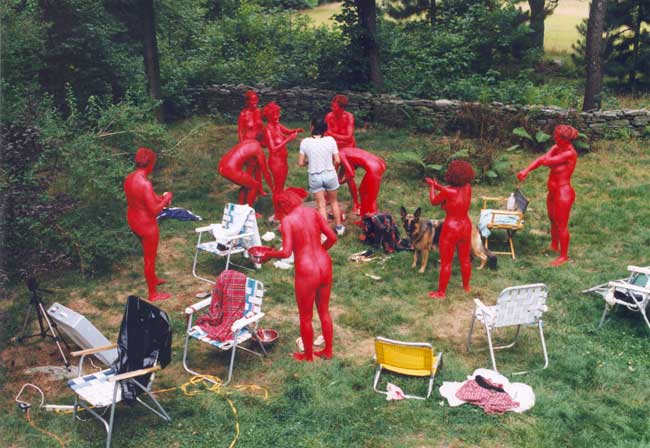Performance Rituals
In 1979, Still Dance began in my mind’s eye and lived there for several years. I vividly remember my first calling. I was a passenger driving along the coast of Northern California, dreaming onto the land. It was an open hillside in the distance where I began my visual dialogue. I imagined hundreds of yellow figures on that hillside jumping. This image was startling, and to this day I have yet to bring it into the world. From that moment on, this kind of perception haunted me. Whenever something in the land called out to me, I would see a body or sometimes many bodies joined with it.
Several years later, when I finally gave form to these images, I felt like what Helen Keller must have felt like when she first grokked what Anne Sullivan was tapping into her hands. My body wanted to place itself with everything it could, curled beneath the jagged crack of a cliff, giving over to a field of grass…
Since then, my work has been focused on two intentions equally; the internal, ephemeral experience of the performer and the permanent visual piece, the photograph.
When I am developing a group performance ritual, I begin with the initial image of the body in the landscape, but it takes many months to write the final score. I try to weave two focuses—the experience and the photograph. I do not want to sacrifice one for the other. There are definitely cases where I haven’t accomplished this marriage, and it is the photograph that suffers.
In all my work, there are no rehearsals. Many of the performers have never performed before. The day of the event is the first time they come together. I will have had many conversations with each performer beforehand so they have a vague idea of what the piece will entail. Each piece begins with the introduction of the participants to each other, and with the photographers, and then a going over of the score (which is in written form). In some cases (take Imbolc for example), I will lead them through movement, writing and drawing explorations to get at inner material that is essential for the piece. But in most cases, I depend on the costume and set of activities to transport their psyches and spark their imaginations. In all cases, the site itself is what is most mysterious to me. I can only imagine the possibilities. Each element in nature shapes the dance. After the score, the land becomes the final choreographer. I can work months on a piece and when the day of performance arrives, what the day brings to the chosen site of performance, I have no control over, and this is what thrills me the most.
More to come…
Eeo Stubblefield

